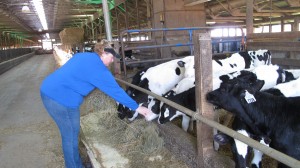More pollution flowing into Chesapeake Bay than expected
-
Marie Cusick

Marie Cusick/ StateImpact Pennsylvania
Lisa Graybeal is a third generation dairy farmer in Lancaster County.
After decades of work and billions of dollars spent, a massive effort is still underway to clean up the Chesapeake Bay. In 2010, Pennsylvania and other states in the watershed began a new plan to restore the health of the bay—with the goal to fully implement pollution reduction practices by the year 2025.
But new data shows more nitrogen and sediment is running off into the bay than previously expected.
“What happens in Pennsylvania”
As Lisa Graybeal walks around her family dairy farm, she thinks about how times have changed.
“In 1942, they milked 60 jerseys in a bank barn,” she says.
That was back in her grandfather’s day. Now there are 720 cows, milked with machines.
“My dad remembers when they still had a horse to do things, but it was soon after they moved here that they got the first tractor.”
Her 1,200 acre farm in Fulton Township is in the southern most portion of Lancaster County, along the Pennsylvania-Maryland border. It’s one of many in the Chesapeake Bay watershed.
No other state contributes more pollution to the bay than Pennsylvania, and its farms are the largest source of nutrient and sediment pollution. Graybeal says she feels like farmers get a bad rap. They’ve been stewards of the land, and she’s always tried to use best management practices.
“We’ve gone on with cover cropping, which was done here in the 70’s and early 80’s,” she says. “We do not plough anymore. We do all no-till cropping.”
Despite efforts from people like Graybeal, what happens in Pennsylvania does not always stay in Pennsylvania.
Katherine Antos tracks bay water quality for the federal Environmental Protection Agency, which is part of the Chesapeake Bay Program— a regional partnership that includes the District of Columbia, Pennsylvania, Delaware, Maryland, New York, Virginia, and West Virginia. All have agreed to implement pollution reduction practices to meet 60 percent of the goal by 2017.
“What happens in Pennsylvania has a very large impact on the Chesapeake Bay,” says Antos.
Farming certainly isn’t the sole source of pollution. Antos says two pollution sources that have seen major reductions in recent decades are the wastewater sector and atmospheric deposition—air pollution contaminating waterways. But new Chesapeake Bay Program data shows more work needs to be done on runoff from urban areas, septic systems from suburban development, and farming.
“Nitrogen and sediment reductions are not on track with the partnership’s long-term water quality goals,” says Antos. “There’s more entering the bay than we previously thought.”
Even though those levels are not on track, phosphorus pollution reductions are ahead of schedule.
“We’re still moving in the right direction,” she says.
Costs vs. benefits
But the question inevitably arises—who bears the costs, and who gets the benefits? If farmers like Lisa Graybeal have to spend more money to curb pollution, or cut land out of production, that may be good for fishermen in Maryland, but it could hurt farmers’ bottom lines upstream.
“We believe EPA has clearly exceeded its authority under the Clean Water Act.” says Mark O’Neil, a spokesman for the Pennsylvania Farm Bureau.

Chris Gardner / AP Photo
Fisherman on the Susquehanna River. It supplies half the freshwater flowing into the Chesapeake Bay.
The group is part of a lawsuit challenging the EPA’s authority over the bay cleanup efforts. The case is currently pending in a federal appeals court.
“We want to make sure our farm families are not put in a situation that threatens the economic viability of the farm family,” he says. “Especially in the future.”
But if you look at the bay itself, and all the economic services it provides–like food, water, aesthetics, and recreation—the benefits of cleaning it up may be well worth it. That’s the conclusion of a new economic report from the Chesapeake Bay Foundation.
Economist Spencer Phillips wrote the report and says if all the pollution plans are in place by the 2025 target, the economic benefits could be more than $22 billion per year.
“It looks like the benefits are going to far outweigh the costs, by a ratio of something like four to one, by our estimates.”
Back on her Lancaster County farm, Lisa Graybeal stands on a hillside and admires the rolling landscape. As the crow files, we’re just a few miles from the Susquehanna River—which supplies half the freshwater for the Bay.
“For years and generations we’ve done these practices,” she says. “We want to see clean streams, creeks and rivers– as anyone else does.”
She says it’s a goal she’ll keep working towards.
















